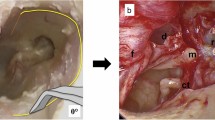Abstract
To determine the impact of using otoendoscopy at the time of primary surgery of cholesteatoma in identifying hidden “cholesteatoma remnant”. Study was prospective study. Setting was University tertiary care hospital. One hundred fifty, patients diagnosed clinically and by CT as having cholesteatoma, have been operated. 64 patients operated by using canal up technique and 86 patients operated by using canal down technique. Once all visible cholesteatoma was removed with standard microscopic techniques, otoendoscopy was utilized in every patient to identify any hidden “cholesteatoma remnant”. Despite apparent total microscopic eradication of cholesteatoma of the operated cases, otoendoscopy at time of primary surgery revealed an overall incidence of hidden cholesteatoma remnants of 18%. The incidence of hidden cholesteatoma remnants identified by otoendoscopy was 23% in the canal up group and 14% in the canal down group. Otoendoscopy should be used as an adjunct with standard microscopic technique to identify hidden cholesteatoma remnants during surgery of cholesteatoma.
Similar content being viewed by others
Abbreviations
- CSOM:
-
Chronic suppurative otitis media
- CWD:
-
Canal wall-down
- CWU:
-
Canal wall-up
References
Nyrop M, Bonding P (1997) Extensive cholesteatoma: long term results of three surgical techniques. J Laryngol Otol 111:521–526
Gaillardin L, Lescanne E, Morinière S et al (2012) Residual cholesteatoma: prevalence and location. Follow-up strategy in adults. Eur Ann Otorhinolaryngol Head Neck Dis 129:136–140
Haginomori S, Takamaki A, Nonaka R et al (2008) Residual cholesteatoma: incidence and localization in canal wall down tympanoplasty with soft-wall reconstruction. Arch Otolaryngol Head Neck Surg 134:652–657
Tomlin J, Chang D, Mc Cutcheon B et al (2013) Surgical technique and recurrence in cholesteatoma: a meta-analysis. Audiol Neurootol 18:135–142
McKennan KX (1993) Endoscopic ‘second look’ mastoidoscopy to rule out residual epitympanic/mastoid cholesteatoma. Laryngoscope 103:810–814
Badr-Eldine M (2002) Value of ear endoscopy in cholesteatoma surgery. Otol Neurotol 23:631–635
El-Meselaty K, Badr-Eldine M, Mandour M, Mourad M, Darweesh R (2003) Endoscope affects decision making in cholesteatoma surgery. Otolaryngol Head Neck Surg 129:490–496
Yung MW (2001) The use of middle ear endoscopy: has residual cholesteatoma been eliminated? J Laryngol Otol 115:958–961
Ayache S, Tramier B, Strunski V (2008) Otoendoscopy in cholesteatoma surgery of the middle ear. What benefits can be expected? Otol Neurotol 29(8):1085–1090
Abdel Baki F, Badr-Eldine M, El Saiid I, Bakry M (2002) Sinus tympani endoscopic anatomy. Otolaryngol Head Neck Surg 127:158–162
Syms MJ, Luxford WM (2003) Management of cholesteatoma: status of the canal wall. Laryngoscope 113:443–448
Kinney SE (1982) Five years experience using the intact canal wall tympanoplasty with mastoidectomy for cholesteatoma: preliminary report. Laryngoscope 92:1395–1400
de Zinis LO, Tonni D, Barezzani MG (2010) Single-stage canal wall-down tympanoplasty: long-term results and prognostic factors. Ann Otol Rhinol Laryngol 119:304–312
Sanna M, Facharzt AA, Russo A et al (2009) Modified Bondy’s technique: refinements of the surgical technique and long term results. Otol Neurotol 30:64–69
Mishiro Y, Sakagami M, Okumura S et al (2000) Postoperative results for cholesteatoma in children. Auris Nasus Larynx 27:223–226
Badr-Eldine M (2002) Value of ear endoscopy in cholesteatoma surgery. Otol Neurotol 23:631–635
Presutti L, Marchioni D, Mattioli F et al (2008) Endoscopic management of acquired cholesteatoma: our experience. J Otolaryngol Head Neck Surg 37:481–487
Ayubi A, Gill M (2011) Oto-endoscopy for resduial disease after radical and modified radical mastoidectomy for cholesteatoma. JUMDC 2(1):33
Ayache S, Tramier B, Strunski V (2008) Otoendoscopy in cholesteatoma surgery of the middle ear: what benefits can be expected? Otol Neurotol 29:1085–1090
Presutti L, Gioacchini F, Alicandri-Ciufelli M, Villari D, Marchioni D (2014) Results of endoscopic middle ear surgery for cholesteatoma treatment: a systematic review. Acta Otorhinolaryngol Ital 34:153–157
Author information
Authors and Affiliations
Corresponding author
Ethics declarations
Conflict of interest
None.
Rights and permissions
About this article
Cite this article
Elfeky, A.E.M., Khazbzk, A.O., Nasr, W.F. et al. Outcomes of Using Otoendoscopy During Surgery for Cholesteatoma. Indian J Otolaryngol Head Neck Surg 71 (Suppl 2), 1036–1039 (2019). https://doi.org/10.1007/s12070-017-1084-7
Received:
Accepted:
Published:
Issue Date:
DOI: https://doi.org/10.1007/s12070-017-1084-7




